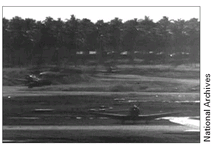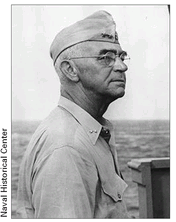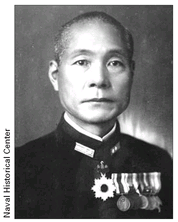War Stories II (33 page)
Authors: Oliver L. North

Scarce resources weren't the only problem for Nimitz. In the aftermath of the victory at Midway, the
Chicago Tribune
, owned and published by FDR's political adversary, Colonel Robert McCormick, ran a story on how the U.S. had broken the Japanese JN-25 code. It became front-page news across America, and Tokyo quickly replaced the compromised codesâleaving Nimitz and his forces in the dark regarding Japanese intentions. Roosevelt was fit to be tied and ordered Attorney General Francis Biddle to arrest McCormick, a World War I hero, and put him on trial for treasonâa wartime crime punishable by death.
Chicago Tribune
, owned and published by FDR's political adversary, Colonel Robert McCormick, ran a story on how the U.S. had broken the Japanese JN-25 code. It became front-page news across America, and Tokyo quickly replaced the compromised codesâleaving Nimitz and his forces in the dark regarding Japanese intentions. Roosevelt was fit to be tied and ordered Attorney General Francis Biddle to arrest McCormick, a World War I hero, and put him on trial for treasonâa wartime crime punishable by death.
In Washington, Admiral King tried to calm things down, believing that a sensational trial would reveal even more classified informationâparticularly the U.S.âBritish “Ultra” project that was busily breaking German war codes. He succeeded in convincing FDR that the best damage control for Station Hypo and other cryptological efforts would be to let the story die.
Â
Henderson Field

Newspaper stories about Midway weren't a problem in Japan. There, the stunning defeat at Midway had been carefully covered up. Prime Minister Tojo had ordered that there be no news of their humiliation and no one involved was to even talk about it. Wounded sailors hospitalized in Japan were isolated so no one could ask them questions about what had taken place at Midway. Instead of news about the catastrophe, Japanese newspapers printed glowing reports about “fantastic Japanese victories” in the
northern Pacific, where they'd bombed the islands of Attu and Kiska, two barren, icy dots in the long chain of Aleutian Islands off the coast of Alaska.
northern Pacific, where they'd bombed the islands of Attu and Kiska, two barren, icy dots in the long chain of Aleutian Islands off the coast of Alaska.
 HQ 1ST MARINE DIVISION
HQ 1ST MARINE DIVISIONLUNGA POINT, GUADALCANAL
8 AUGUST 1942
2000 HOURS LOCAL
8 AUGUST 1942
2000 HOURS LOCAL
By the afternoon of 8 August, General Vandegrift was satisfied that all his 1st Marine Division needed for success was to complete the offload of supplies from the transports lying at anchor offshore. On Guadalcanal, the uncompleted airfield was already in U.S. hands and renamed Henderson Field in honor of Major Lofton Henderson, who had been killed leading his bombing squadron during the Battle of Midway.
Nineteen miles north, across the water, Brigadier General William Rupertus reported that his Leathernecks had finally secured Tulagiâthough it had required killing nearly all of the entrenched Japanese defenders. The Marines had withstood several determined banzai charges and desperate hand-to-hand combat over a period of thirty-one hours, but the Americans finally prevailed. Rupertus had lost 115 Marines and seven Navy medical corpsmen in the fight, but the Americans had killed ten enemy soldiers to every one of their own.
Â
Admiral Richard K. Turner

Earlier in the day, a second Japanese aerial attackâthis time by torpedo bombersâhad been met first by U.S. carrier aircraft and then by overwhelming anti-aircraft fire from the fifty-five American transports, cruisers, and destroyers in the waters south of Savo Island. Though nearly all of the attackers were eventually downed, by the time the air battle was over, eighteen of Admiral Turner's carrier aircraft had
been lost, the transport
USS Elliot
had been sunk, and two destroyers were badly damaged. One of themâthe
USS Jarvis
âheaded for Noumea but sank en route. Though these losses weren't insignificant, Vandegrift was more concerned that the two attacks had seriously disrupted the offload of supplies and equipment urgently needed by his Marines ashore.
been lost, the transport
USS Elliot
had been sunk, and two destroyers were badly damaged. One of themâthe
USS Jarvis
âheaded for Noumea but sank en route. Though these losses weren't insignificant, Vandegrift was more concerned that the two attacks had seriously disrupted the offload of supplies and equipment urgently needed by his Marines ashore.
As darkness fell on 8 August, few of the transports had landed more than 30 percent of their cargo. Vandegrift importuned Admiral Turner to have the transports remain in the anchorage for another forty-eight hours. Shortly after Turner approved, Admiral Fletcher informed him that he would have to take
Saratoga
,
Enterprise
, and
Wasp
well south of Guadalcanal to refuel, since the loss of eighteen aircraft that morning made replenishing his carriers that far north too risky. Just hours later, MacArthur's headquarters belatedly informed Turner that an Australian patrol plane had spotted several Japanese ships, “probable seaplane tenders” headed toward Guadalcanal from Rabaul.
Saratoga
,
Enterprise
, and
Wasp
well south of Guadalcanal to refuel, since the loss of eighteen aircraft that morning made replenishing his carriers that far north too risky. Just hours later, MacArthur's headquarters belatedly informed Turner that an Australian patrol plane had spotted several Japanese ships, “probable seaplane tenders” headed toward Guadalcanal from Rabaul.
Lacking the kind of intelligence Station Hypo had provided at Midway, Turner and Vandegrift didn't know that the Japanese group bearing down on them was actually a formidable surface action force comprising seven cruisers and a destroyerâall commanded by Vice Admiral Gunichi Mikawa. Operation Watchtower was about to come unraveledâand would soon live up to the nickname the Marines ashore had already given itâOperation Shoestring.
 IMPERIAL JAPANESE NAVY FLAGSHIP CHOKAI
IMPERIAL JAPANESE NAVY FLAGSHIP CHOKAINORTH OF SAVO ISLAND, SOLOMON ISLANDS
9 AUGUST 1942
0530 HOURS LOCAL
9 AUGUST 1942
0530 HOURS LOCAL
The senior Japanese naval commander in the South Pacific, Vice Admiral Gunichi Mikawa, was bent on vengeance. He had been humiliated by the losses at Midway, and within hours of being informed of the Marine landings on Tulagi and Guadalcanal immediately decided to counter-attack. On the afternoon of 7 August, he ordered every available combatant at Rabaul
to sortie after dark and follow him south in his flagship, the heavy cruiser
Chokai
, to engage the American ships at Guadalcanal.
to sortie after dark and follow him south in his flagship, the heavy cruiser
Chokai
, to engage the American ships at Guadalcanal.
A few minutes after 0100 on 9 August, Mikawa's ships exited the southern end of the slotâthe narrow passage between New Georgia and Santa Isabel islandsâand entered Savo Island Sound north of Cape Esperance on Guadalcanal. The Americans, completely unprepared, first learned of Mikawa's presence when his cruisers opened fire at close range with guns and torpedoes. The USS
Chicago
and HMAS
Canberra
were struck in the first volley and put out of action. Mikawa then split his force into two columns and swung north to engage the
Vincennes
,
Astoria
, and
Quincy
. Within minutes all three heavy cruisers were dead in the water, afire and listing heavily.
Chicago
and HMAS
Canberra
were struck in the first volley and put out of action. Mikawa then split his force into two columns and swung north to engage the
Vincennes
,
Astoria
, and
Quincy
. Within minutes all three heavy cruisers were dead in the water, afire and listing heavily.
Â
Gunichi Mikawa. His ships were dubbed the Tokyo Express.

At 0220, Mikawa, fearing an air attack, ordered his force to withdraw without engaging the now defenseless transports. As the Japanese cruisers passed north of Savo Island and raced back up the slot, they nearly collided with the U.S. destroyer
Talbot.
Without slowing down, every passing cruiser pumped heavy shells into the hapless picket shipâkilling scores of sailors and wrecking her superstructure.
Talbot.
Without slowing down, every passing cruiser pumped heavy shells into the hapless picket shipâkilling scores of sailors and wrecking her superstructure.
The engagement had lasted little more than an hour, but it had cost the Allies dearly. The U.S. heavy cruisers
Vincennes
and
Quincy
were on the bottom before dawn. The crippled Australian heavy cruiser
Canberra
was abandoned and had to be sunk by an American destroyer at 0800. The USS
Astoria
finally went down at 1145.
Vincennes
and
Quincy
were on the bottom before dawn. The crippled Australian heavy cruiser
Canberra
was abandoned and had to be sunk by an American destroyer at 0800. The USS
Astoria
finally went down at 1145.
The
Chokai
had taken a single hit from an eight-inch gunâlikely the
Astoria
'sâand Admiral Mikawa celebrated his victory. The engagement had cost the Japanese fifty-eight dead and fifty-three wounded. Though Mikawa didn't know the full magnitude of the U.S. and Australian lossesâ1,023 dead and 709 woundedâhe was certain that he had struck back hard at those who had inflicted such losses on the emperor's fleet at Midway.
Chokai
had taken a single hit from an eight-inch gunâlikely the
Astoria
'sâand Admiral Mikawa celebrated his victory. The engagement had cost the Japanese fifty-eight dead and fifty-three wounded. Though Mikawa didn't know the full magnitude of the U.S. and Australian lossesâ1,023 dead and 709 woundedâhe was certain that he had struck back hard at those who had inflicted such losses on the emperor's fleet at Midway.
The Battle of Savo Island also convinced Mikawa that Japanese sailors were superior at night fighting. This impression would govern his tactics in the months to come as he sought to wrest control of Guadalcanal from the Marines. The Americans might have more carriers and the ability to control the skies in daylight. But he was determined that the Japaneseâwith years of night gunnery trainingâcould dominate the seas in darkness.
 1ST MARINE DIVISION COMMAND POST
1ST MARINE DIVISION COMMAND POSTGUADALCANAL, SOLOMON ISLANDS
21 AUGUST 1942
1600 HOURS LOCAL
21 AUGUST 1942
1600 HOURS LOCAL
For General Vandegrift and his Marines on Guadalcanal, Tulagi, Florida, and Gavutu-Tanambogo, the days after the Battle of Savo Island were a matter of making do with less and less. On the afternoon of 9 August, Admiral Turner, fearing another night attack by Mikawa's cruisers, had ordered the transports to withdraw to the south toward Noumea, carrying with them more than half the supplies and equipment as well as 2,000 of the division's Marines.
Other books
The Lair by Emily McKay
I Serve by Rosanne E. Lortz
The Hum and the Shiver by Alex Bledsoe
Fire at Twilight: The Firefighters of Darling Bay 1 by Ashe, Lila
Dragon Defense (Heirs to the Throne Book 3) by Diane Rapp
Destiny Revealed (There's Always Tomorrow Book 2) by Saperstein, M.D.
Goldenhand by Garth Nix
A Karma Girl Christmas by Jennifer Estep
The Surrendered by Chang-Rae Lee
SYLVIE'S RIDDLE by WALL, ALAN
